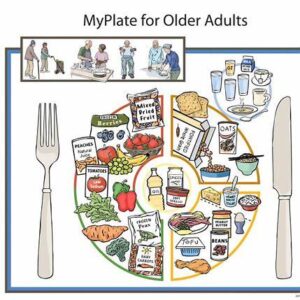Some older adults:
-
Skip breakfast or lunch
-
Eat most of their calories late at night
-
Graze on snacks instead of having balanced meals
This can cause large blood sugar swings, fatigue and weight gain, and may worsen mood and sleep.
1.4 Not enough protein
With age, the body loses muscle more easily. Many seniors still eat like they did at 30—small portions of protein or only one “real” meal per day—so they may get too little protein, especially in the morning. That leads to:
-
Loss of muscle and strength
-
Higher risk of falls
-
Slower recovery after illness
1.5 Chronic dehydration
A lot of older adults simply forget to drink or avoid fluids to reduce bathroom trips. Mild dehydration is very common and can cause:
-
Headaches, fatigue, constipation
-
Confusion and low mood
-
Higher risk of urinary infections
1.6 Sedentary lifestyle and isolation
Physical activity declines with age, and many seniors spend most of the day sitting at home or watching TV. Only about 1 in 7 older Americans meet federal guidelines for both aerobic and muscle-strengthening activity. PubMed+1
At the same time, loneliness and social isolation are major problems among older adults in Western countries, and they are linked to poorer diet quality and lower physical activity. MDPI+3PMC+3ScienceDirect+3
Together, sedentary habits and isolation increase the risk of:
-
Depression and anxiety
-
Cognitive decline
-
Heart disease, stroke and early mortality
2. How These Habits Affect Mood and Mental Health

Food and routine directly influence brain chemistry and emotional balance.
-
Too much sugar and refined carbs → rapid spikes and drops in blood sugar → irritability, cravings, low energy. Center for Science+1
-
Low intake of fruits, vegetables and whole grains → lower levels of key micronutrients (like magnesium, B vitamins, vitamin C), which are important for mood regulation and brain function. OUP Academic+1
-
Lack of protein → insufficient amino acids for neurotransmitters such as serotonin and dopamine.
-
Dehydration and lack of movement → fatigue, headaches, joint stiffness, which can increase irritability and reduce motivation.
-
Social isolation → strong association with depression, anxiety and reduced quality of life in older adults. Santé et Services sociaux+1
On the positive side, long-term research shows that healthy dietary patterns rich in plant foods, whole grains, nuts, beans and healthy fats are linked with better physical and mental health in older age. The Washington Post+1
3. What an “Ideal” Eating Pattern Looks Like for Older Adults
The Dietary Guidelines for Americans 2020–2025 and tools like MyPlate for Older Adults give a clear picture of what a healthy pattern looks like. PMC+2MyPlate+2
3.1 Basic principles
For most healthy older adults:
-
Half the plate: Vegetables and fruits (fresh, frozen or low-sodium canned) in many colors
-
One quarter: Whole grains (oatmeal, brown rice, whole-wheat pasta, quinoa)
-
One quarter: Protein foods (fish, poultry, beans, lentils, tofu, eggs, lean meats)
-
Dairy or fortified alternatives: Low-fat milk, yogurt or fortified plant drinks for calcium and vitamin D
-
Healthy fats: Olive or canola oil, nuts, seeds, avocado
Key limits:
-
Added sugars: preferably well under 10% of daily calories
-
Saturated fat: less than 10% of calories, replacing with unsaturated fats
-
Sodium: avoid very salty processed foods and added salt at the table Center for Science+1
3.2 Special points for seniors
-
Protein at every meal (15–30 g): e.g., eggs at breakfast, beans or fish at lunch, yogurt or lean meat at dinner.
-
Fiber: vegetables, fruits, beans and whole grains to support digestion and cholesterol.
-
Fluids all day: water, herbal tea, soups; limit sugary drinks and excessive alcohol.
-
Easy-to-prepare options: frozen vegetables, pre-washed salads, canned beans, pre-cut fruit can make healthy eating realistic even with less energy.
4. A Simple Daily Routine for Better Mood and Health
Here is a realistic daily routine that combines ideal nutrition, movement and mental well-being for an older adult in the USA. It can be adapted to individual health conditions and cultural food preferences.
Morning (7:00–10:00)
1. Gentle wake-up
-
Open the curtains to get natural light (helps reset the body clock).
-
Drink a glass of water as soon as you get up.
2. Balanced breakfast
-
Example:
-
Oatmeal made with low-fat milk, topped with berries and a spoon of nuts or seeds
-
OR scrambled egg with whole-grain toast and a piece of fruit
-
-
Benefit: Stable energy, protein for muscles and brain, fiber for digestion.
3. Light movement
-
10–15 minutes of stretching or chair exercises
-
Short walk outside if possible
The CDC recommends at least 150 minutes per week of moderate-intensity activity (about 30 minutes a day, 5 days a week), plus muscle-strengthening and balance exercises. CDC+3CDC+3Restored CDC+3
Midday (12:00–14:00)
4. Social, calm lunch
-
Example plate:
-
Half plate salad or cooked vegetables
-
A quarter plate brown rice or whole-grain bread
-
A quarter plate grilled fish, beans or chicken
-
A small yogurt or piece of fruit for dessert
-
Whenever possible, share meals with family, friends, neighbors or community centers to reduce isolation.
Afternoon (15:00–18:00)
5. Active break
-
Short walk, gardening, light housework or a group exercise class adapted to seniors.
-
Small healthy snack if needed: fruit + a handful of nuts, or yogurt.
6. Mental and emotional nourishment
-
Read, listen to music, practice a hobby (crafts, puzzles, learning something new).
-
Make at least one social contact: a phone call, video call, or visit.
Evening (18:00–22:00)
7. Light, early dinner
-
Vegetable-based soup plus a small portion of lean protein
-
Or a vegetable omelet with a side salad and whole-grain toast
Avoid very heavy, salty or sugary meals at night to protect sleep and digestion.
8. Screen-down time and sleep routine
-
Reduce screens 1 hour before bed; choose calming activities (reading, light stretching, prayer/meditation).
-
Aim for 7–8 hours of sleep if possible; good sleep helps mood regulation and appetite control.
5. Small Steps to Change at Any Age
Improving health and morale does not require perfection. For an older adult in the USA, realistic goals might be:
-
Add one piece of fruit a day and one extra vegetable at dinner.
-
Replace one sugary drink with water or unsweetened tea.
-
Take a 10-minute walk twice a day and slowly build up.
-
Join a senior center, walking group or community meal program to reduce isolation.
-
Talk with a doctor or dietitian before major diet changes, especially if there are chronic conditions.
Even small adjustments, maintained over time, can make a big difference to both physical health and emotional well-being. MyPlate+1

